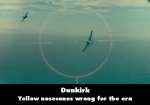Continuity mistake: At the start the damage to the wooden gates changes between shots. (00:02:10)
Continuity mistake: There's a repeated issue with weather continuity throughout the movie. Many scenes cut between daylight, sunset and cloudy weather literally seconds apart. This has nothing to do with the particular time structure of the movie, since it happens between shots and reverse shots of the same scenes. These inconsistencies are particularly obvious at the opening scene, at the Stuka bombing and at the rescue of the shivering soldier. In these scenes, weather turns from heavily cloudy to fully sunny just from one shot to the next. (00:26:20)
Other mistake: When Tommy walks down the stairs on the boat to be bombed, one of the soldiers in the top middle of the left side of the screen can be seen pretending to eat a sandwich by repeatedly snapping his teeth near the edge of the crust. (00:31:15)
Factual error: In several scenes, but notably very near the end, the background shows numerous container handling cranes, which weren't invented until the mid sixties. (00:51:40)
Factual error: In the silent overfly of the plane that ran out of fuel in the background you see a lot of modern architecture that is definitely not from the 1940s. (01:30:15)
Visible crew/equipment: Towards the end of the movie when Farrier is watching his airplane burning on the beach, a camera crane can be seen from a distance getting in the frame on the right side of the screen. (01:38:40)

Deliberate mistake: The Messerschmitts have painted yellow fronts, this wasn't done by the Germans until after Dunkirk. Christopher Nolan has admitted doing this deliberately so the audience could tell the difference between the Spitfire and the Messerschmitt during the combat scenes.
Factual error: In the scene towards the start of the film in Weymouth harbour, you can see the huge building which is Weymouth Pavilion, which was built in 1954, after the original 1909 building burnt down.
Factual error: When the returning soldiers are on the train at the end of the film, it's an open plan post-war British Rail Mark I type, which where built from around 1950. Also the blue upholstery on the seats looks to be the corporate blue introduced by British Rail in the 1960s, used by the preserved railway owning the stock, and not what would have featured in Southern Railway carriages of the time. The carriages also have horizontally-sliding windows, which are far more contemporary than wartime trains, which had windows with a much larger vertical opening, held in place by a leather strap.
Factual error: There are a number of scenes of the buildings along the coast where TV antennae are visible.
Factual error: When the boat returns to England they state the cliffs are Dorset. There were 3 evacuation routes from Dunkirk - all to Kent. It would be nonsense to sail from Dunkirk to Dorset as you have to almost pass Dover on the way. Never mind the fact the boat would probably not have made it without refuelling.
Continuity mistake: When the Stukas are shown bombing the beach, they drop a single bomb, but from beach level, you see sticks of bombs landing.
Suggested correction: The Stukas are dropping SD-2 canister bombs, a particularly nasty anti-personnel weapon. Upon release from the aircraft the bomb divided into the bomblets you see here.
First known use was bombing of England, no evidence they were used at Dunkirk. Also, the SD-2 was smaller and produced numerous small explosions. The ones we see in Dunkirk are larger and much bigger than anything the little SD-2 could ever produce - so the original criticism sticks.
Continuity mistake: The sea often changes state from shot to shot. One minute we've got a reasonable Force 4 blowing and some surf, the next it's 'sea like a mirror' and then there's everything between.
Other mistake: In the scene at the end where Farrier gazes upon his burning Spitfire on the beach, the propeller appears to be supported at the end of a simple rod. In fact the propeller would have been attached to a rather solid engine. There's also no internal structure - the entire spitfire was reduced to ashes which was impossible as this was a metal aircraft. Unlike the Wellington, Mosquito or Hurricane which were partly timber and canvas.
Other mistake: When the pilot of the Spitfire is shown ditching into the water, his engine is windmilling at high RPM as he impacts the water. This would have resulted in all of the prop blade tips being bent backwards; however, as it shows him trying to escape the sinking airplane, the prop blades are perfectly straight.
Revealing mistake: The ship set up for the capsize scene is supposedly mid channel and heading for England when it is bombed by the Heinkel, but it is at anchor.
Factual error: Not until the very end of the 10-day evacuation were the French (or British for that matter) defending the very beaches themselves, and yet the movie opens with the French roadblock doing just that.
Suggested correction: While it is true the main German assault did not occur until near the end of the evacuation, what we see in the movie actually fits quite well with what really occurred. As the German Army approached, the French Army began to build defenses and roadblocks in and around Dunkirk, as well as within the city itself. The amount of gunfire we hear (just a few small arms shooting) at the beginning of the movie is indicative of a chance encounter between a German and a British patrol. While preparing for the final assault on Dunkirk, the Germans would be sending in scouting patrols to see what defenses were built and where they were located.
Firstly a scouting patrol would not open fire and give their presence away. Then the British patrol would not flee throwing away their weapons as they would know the city to be in Allied control with lots of Allied troops around. Barricades across the roads leading to the beach would obstruct Allied soldiers access to the beach, barricades would only be put up at the last moment and only to obstruct the Germans. The period is at least a week before the evacuation was completed, so the German army was miles away and there would be hundreds of thousands of Allied soldiers in and around Dunkirk. I am sorry but I had the distinct impression the Germans were only a short distance from the beach.
Having both studied and taught military history, within the military, for over 40 years, with particular emphasis on World War Two, in my expert opinion, what we see occur at the beginning of the movie is completely within the realm of factual history. Demoralized British troops have an unexpected encounter with advanced German troops entering Dunkirk ahead of the main attack to come; the Germans open fire with small arms; the demoralized British troops scatter in panic without resisting. Once it became apparent to the French they would be making a last stand defense at Dunkirk, the French did in fact begin preparing defenses. They would have been derelict not to have done so. While what we see in the skirmish at the beginning of the movie can't be pinned down to any actual engagement, it is plausible enough to be a factual representation of what occurred in and around Dunkirk at that time.
One of the things the film doesn't show is that in reality the town would have been heavily bomb damaged.
If you look very closely at the scene where Tommy's trying to load his rifle and fire in the back garden (or wherever it was) you can just about see a figure in one of the balconies in the houses in the street behind. So most likely a sniper. Also originally it was assumed the Germans were just 36 hours away when the evacuation started so it wouldn't be entirely out of the realms of possibility for a French street barricade to have been put up.
Factual error: Near the start of the film in the harbour when the camera pans around to the left looking out to sea, you can see the back of the modern Weymouth Lifeboat 17-32 moored up in the background.
Factual error: The Spitfire had enough browning MG ammunition for 16 seconds, hence pilots shot in very short bursts. In the film at least 30 seconds of fire came from one aircraft.
Factual error: When told instructed by Fortis leader to stay at 500 feet to leave 40 mins of fighting time. Pilot confirms saying ".5" however for altitudes under 1000 feet "cherub" would have been used - "cherub 5" being 500 feet.





